The design of a new sound system for the sanctuary of The Pentecostals of the Fox Cities in Menasha, WI, was particularly challenging. This 500-seat auditorium has a 12-foot ceiling, dictating loudspeakers that are very compact in order to not detract from the room’s aesthetics.
To meet this requirement, we chose premium two-way loudspeakers, with six of these cabinets flown in their horizontal cabinet position (with mid/high-frequency horns rotated), carefully placed in a distributed, decentralized arrangement.
Largely due to compact design of these loudspeakers, frequency response doesn’t extend much below 90 Hz. Therefore, we also needed subwoofers to reinforce frequencies beneath the 90 Hz point to meet a stated design goal of providing a system offering true full-range capabilities.
Finding a location for the subwoofers in this sanctuary proved to be a challenge. Placed on the platform, they would tend to distract the musicians and singers while flooding the area with feedback-inducing LF energy. And the ceiling was far too low to consider flying them.
Fortunately, the construction of a sound isolation drum booth on the platform necessitated extending the platform outward. We seized this opportunity, deciding to put the subs under the platform extension. Of course, this direction presented its own set of challenges. The platform height would be a tight 24 inches, leaving much less than that to realistically work with.
Evaluating possible solutions, we chose a pair of EAW SBX220 dual-12-inch-loaded subwoofers that are only 18 inches tall while capable of handling the 5,000 watts we wanted to deliver to them. (There are other viable options meeting this criteria, by the way.)
The next challenge: Isolating the low-frequency (LF) energy produced by the subs from the platform. Without proper isolation, the entire space under the platform could tend to act as a “resonation chamber” causing uneven frequency response and feedback.
Working with a Mark McLernon, a skilled carpenter from the church, we constructed an isolation solution, a two-chamber box that effectively isolates the low frequency energy from the platform. The dual design of the chamber was necessary to isolate the subwoofers from the platform extension, and then to isolate the extension from the existing platform.
The subwoofer “inner chamber” is constructed of wood and fastened tightly together with glue and screws to prevent rattles and buzzes. All seams are caulked air-tight, furthering isolation properties. The “outer chamber” – built within the airspace between the inner chamber and the platform – is isolated from the platform by using wood and concrete board.
After the two chambers were completed and the subwoofers installed, the space between the inner and outer chambers was hard-packed with insulation to add further damping. The top of the box was then sealed with two layers of plywood.
This approach worked out very well, with the end result as predicted – flat and very smooth low frequency presentation, and the desired full-range overall output that keeps up with the high impact (pun intended) of the church’s youth services.
For much more information and specifics, see my Photo Gallery Tour of this project.
Jeff Lange began his audio/musical career attending Musicians Institute in Hollywood, and has worked in professional audio for more than 20 years in commercial audio/visual system design, project management, system installation, project estimating and training. Jeff is currently working for Bose as the regional sales engineer for the central U.S.















